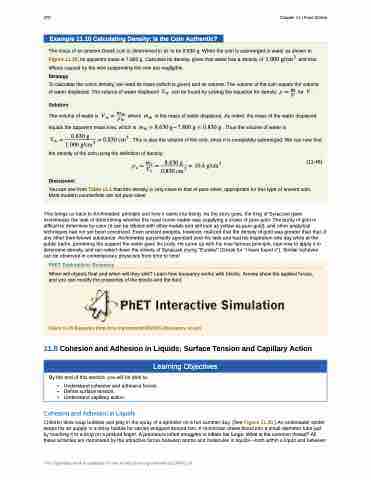Page 482 - College Physics For AP Courses
P. 482
470 Chapter 11 | Fluid Statics
Example 11.10 Calculating Density: Is the Coin Authentic?
The mass of an ancient Greek coin is determined in air to be 8.630 g. When the coin is submerged in water as shown in Figure 11.28, its apparent mass is 7.800 g. Calculate its density, given that water has a density of ����� ����� and that effects caused by the wire suspending the coin are negligible.
Strategy
To calculate the coin's density, we need its mass (which is given) and its volume. The volume of the coin equals the volume of water displaced. The volume of water displaced �� can be found by solving the equation for density � � �� for � .
Solution
The volume of water is � � �� where � is the mass of water displaced. As noted, the mass of the water displaced ��� �
equals the apparent mass loss, which is �� � ����� ������� � � ����� � . Thus the volume of water is
�� � ����� � � � ����� ��� . This is also the volume of the coin, since it is completely submerged. We can now find
the density of the coin using the definition of density:
�� � �� � ����� � � ���� ������ (11.46)
Discussion
You can see from Table 11.1 that this density is very close to that of pure silver, appropriate for this type of ancient coin. Most modern counterfeits are not pure silver.
����� ����
�� ����� ���
This brings us back to Archimedes' principle and how it came into being. As the story goes, the king of Syracuse gave Archimedes the task of determining whether the royal crown maker was supplying a crown of pure gold. The purity of gold is difficult to determine by color (it can be diluted with other metals and still look as yellow as pure gold), and other analytical techniques had not yet been conceived. Even ancient peoples, however, realized that the density of gold was greater than that of any other then-known substance. Archimedes purportedly agonized over his task and had his inspiration one day while at the public baths, pondering the support the water gave his body. He came up with his now-famous principle, saw how to apply it to determine density, and ran naked down the streets of Syracuse crying “Eureka!” (Greek for “I have found it”). Similar behavior can be observed in contemporary physicists from time to time!
11.8 Cohesion and Adhesion in Liquids: Surface Tension and Capillary Action
Cohesion and Adhesion in Liquids
Children blow soap bubbles and play in the spray of a sprinkler on a hot summer day. (See Figure 11.30.) An underwater spider keeps his air supply in a shiny bubble he carries wrapped around him. A technician draws blood into a small-diameter tube just by touching it to a drop on a pricked finger. A premature infant struggles to inflate her lungs. What is the common thread? All these activities are dominated by the attractive forces between atoms and molecules in liquids—both within a liquid and between
PhET Explorations: Buoyancy
When will objects float and when will they sink? Learn how buoyancy works with blocks. Arrows show the applied forces, and you can modify the properties of the blocks and the fluid.
Figure 11.29 Buoyancy (http://cnx.org/content/m55215/1.2/buoyancy_en.jar)
Learning Objectives
By the end of this section, you will be able to:
• Understand cohesive and adhesive forces.
• Define surface tension.
• Understand capillary action.
This OpenStax book is available for free at http://cnx.org/content/col11844/1.14


